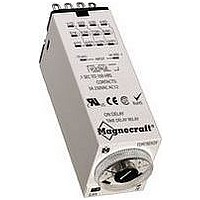TDR782XDXA-110A Magnecraft / Schneider Electric, TDR782XDXA-110A Datasheet

TDR782XDXA-110A
Specifications of TDR782XDXA-110A
Related parts for TDR782XDXA-110A
TDR782XDXA-110A Summary of contents
Page 1
... Time delay relays are simply control relays with a time delay built in. Their purpose is to control an event based on time. The difference between relays and time delay relays is when the output contacts open & close control relay, it happens when voltage is applied and removed from the coil ...
Page 2
... REPEAT CYCLE and time delay t begins. When time delay t is complete, contacts return to Starting On their shelf state for time delay t. This cycle will repeat until input voltage U is removed. Trigger switch is not used in this function. G. Upon application of input voltage U, a single output pulse of 0.5 seconds is PULSE delivered to relay after time delay t ...
Page 3
... Advantages of the TDR782 Time Delay Relay Socket Compatible Mounts Directly On a DIN Rail or Panel. Mating Hold-Down Clip Available Secures Relay to Socket. 5/14 Time Setting Marked with Both IEC Select Between and NEMA Markings 7 Different Time Universal Socket Scales. Compatibility. Excellent Immunity to Interference Conforms to IEC 61812-1/A11 ...
Page 4
... System Solution! The miniature TDR782 series is a single-function, single-voltage time delay relay with multiple time ranges for the ultimate in packaging the most within the smallest space possible in a panel or on the DIN rail. The TDR782 features a screw driver adjust- able knob which allows the user to choose timing ranges and a large knob on top for fine tuning the timing setting ...
Page 5
... TDR782 Time Delay Relay/DPDT, 4PDT Amp Rating UL Recognized WHITE File No. E191122 General Specifications (@ 25°C) Output Characteristics Number and type of Contacts Contact Material Current rating Maximum permissible current Minimum Switching Requirement Indication Input Characteristics Standard Voltage Operating Range Maximum consumption Indication Timing Characteristics ...
Page 6
... U is removed. Control switch is not used in this mode. Standard Part Numbers TDR782XBXA-12D TDR782XBXA-24D TDR782XBXA-24A TDR782XBXA-110A TDR782XBXA-230A TDR782XDXA-12D TDR782XDXA-24D TDR782XDXA-24A TDR782XDXA-110A TDR782XDXA-230A Part Number Builder Series TDR782 = 782 Miniature Timer NOTE: Terminal size is 0.105 x 0.020 0.8 (21 ...










